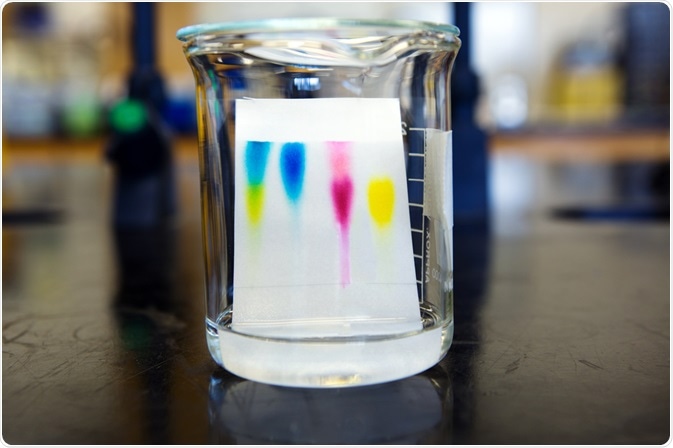Thin-layer chromatography is a chromatography technique that separates pigments, identifying molecules.
While it has many applications in a wide variety of industries, it is a particularly important technique used in forensic labs, helping scientists determine if two pieces of text were written by the same ink, which can often be an indicator of fraud.

Image Credit: ggw/Shutterstock.com
What is thin-layer chromatography?
The technique of chromatography was first used in 1900 by scientist Mikhail Tsvet to separate the pigments of plants. Later, in the 1930s, new chromatography techniques began to emerge, including thin-layer chromatography (TLC) which was also developed for use in separating plant pigments.
The method of TLC involves separating non-volatile compounds by their rate of movement through the stationary phase (a thin layer of adsorbent material, usually silica gel, but sometimes aluminum oxide or cellulose) which is coated onto the glass plate where the process takes place.
Since its invention, TLC has evolved over the decades for use in numerous applications. One of the most prominent applications of the technology is the separation of multicomponent pharmaceutical formulations.
It is also heavily relied on for separating and identifying various colors, preservatives, cosmetic products, and sweetening agents in the food and cosmetic sectors. In addition, forensic science has also adopted TLC that it is used in ink analysis, usually helping to determine if a document has been forged.
Comparing inks to detect fraud
Ink analysis is an incredibly important analytical technique in forensic crime labs. Most commonly, it is used to determine if more than one ink was used on a document, which can help to detect fraud and forgery.
Although, it can be used to reveal a wealth of information about the ink used as well as the substrate it was used on, which can provide invaluable clues in criminal cases.
Numerous substances are contained in modern inks, improving the quality of the ink; however, these substances can be used to characterize the ink in several ways that TLC can detect. Possibly, the most important of these substances contained in the ink are the pigments and dyes used to produce the color of the ink.
While the color of two inks may appear the same to the human eye, this still can provide useful information regarding the document in question.
TLC can reveal characteristic differences in their make-up which allows scientists to see exactly what was written in the original document, and what was added later.
The dyes used in inks are solvable in the “vehicle” or the body of the ink. Pigments, which are finely ground multi-molecular fragments, are not soluble in the vehicle.
As well as dyes and pigments, oils, solvents and resins also exist in the vehicle to dictate how the ink flows and dries. Further to this, driers, detergents, greases, plasticizers, soaps, and waxes are also added into the vehicle for fine-tuning of the ink’s characteristics.
Given the complexity of the molecular mixture of inks along with the possibility of the writing substance contaminating these mixtures, it is easy to see how the forensic analysis of ink presents a significant analytical challenge.
However, most ink analyses run by forensic labs have the main aim of determining whether two samples of text were written by the same ink source. So, comparing the make-up of two inks is the major aim of analyses run by forensic investigations into inks.
Using thin-layer chromatography to analyze ink
Both destructive and non-destructive techniques have been developed for use in ink analysis. However, because of the nature of forensic samples, it is always preferred to use techniques that have a minimal destructive impact on the sample, so it can be retained for possible future testing.
A range of non-destructive approaches are suitable for analyzing inks, including IR absorption and luminescence, Raman spectroscopy, surface-enhanced resonance Raman spectroscopy (SERRS), and UV–vis micro-spectrophotometry.
However, these methods are not without their limitations. For example, the spectrum quality of UV–vis micro-spectrophotometry is very sample-dependent.
Other techniques which require the removal of a small section of the ink are considered to hold benefits over the purely non-destructive methods. Such approaches include high- performance liquid chromatography, infrared spectroscopy (IR), capillary electrophoresis, and TLC.
Research has shown that TLC is a particularly useful method for analyzing inks. Its approach of separating the mixtures that make-up inks into their constituent component dyes and pigments could be highly productive in the comparison of ink samples as well as in the matching of inks to chromatogram databases.
Because of this, TLC has emerged as a commonly used method in forensic labs around the world. As well as being a robust and reliable approach, it is also fast, inexpensive, and requires minimal destruction to the documents.
Sources:
- Djozan, D., Baheri, T., Karimian, G. and Shahidi, M. (2008). Forensic discrimination of blue ballpoint pen inks based on thin-layer chromatography and image analysis. Forensic Science International, 179(2-3), pp.199-205. https://www.sciencedirect.com/science/article/pii/S0379073808002624
- Neumann, C. and Margot, P. (2009). New perspectives in the use of ink evidence in forensic science: Part I. Development of a quality assurance process for forensic ink analysis by HPTLC. Forensic Science International, 185(1-3), pp.29-37. https://www.sciencedirect.com/science/article/pii/S0379073808004684
- Sherma, J. (2016). Advances in the thin-layer chromatographic forensic analysis of inks. Journal of Liquid Chromatography & Related Technologies, 39(12), pp.549-557. www.tandfonline.com/.../10826076.2016.1183130
Further Reading
Last Updated: Mar 20, 2020